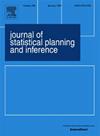随机图的推理由聚类附件演化而来
IF 0.8
4区 数学
Q3 STATISTICS & PROBABILITY
引用次数: 0
摘要
研究了不删除节点和边以及均匀删除节点和边的聚类附件(CA)对随机无向图的演化。在每个进化步骤中,当一个新添加的节点连接到图的两个现有节点时,得到了不删除节点和边的CA的理论结果。理论结果如下:(1)连续平均聚类系数的增量序列趋于零;(2)证明了任意固定节点的节点度序列和三角形计数序列是次鞅。这些结果适用于任何初始图。对节点或边缘均匀删除和不删除的CA进行了仿真研究。结果表明:(1)CA导致了轻尾分布节点度和三角形数;(2)随着时间的推移,平均聚类系数趋于恒定;(3)平均节点度和平均三角形数随时间的增加,随CA参数的增加而增加,并附有实际数据研究。本文章由计算机程序翻译,如有差异,请以英文原文为准。
Inferences for random graphs evolved by clustering attachment
The evolution of random undirected graphs by the clustering attachment (CA) both without node and edge deletion and with uniform node or edge deletion is investigated. Theoretical results are obtained for the CA without node and edge deletion when a newly appended node is connected to two existing nodes of the graph at each evolution step. Theoretical results are the following: (1) the sequence of increments of the consecutive mean clustering coefficients tends to zero; (2) the sequences of node degrees and triangle counts of any fixed node are proved to be submartingales. These results were obtained for any initial graph. The simulation study is provided for the CA with uniform node or edge deletion and without any deletion. It is shown that (1) the CA leads to light-tailed distributed node degrees and triangle counts; (2) the average clustering coefficient tends to a constant over time; (3) the mean node degree and the mean triangle count increase over time with the rate depending on the parameters of the CA. The exposition is accompanied by a real data study.
求助全文
通过发布文献求助,成功后即可免费获取论文全文。
去求助
来源期刊
CiteScore
2.10
自引率
11.10%
发文量
78
审稿时长
3-6 weeks
期刊介绍:
The Journal of Statistical Planning and Inference offers itself as a multifaceted and all-inclusive bridge between classical aspects of statistics and probability, and the emerging interdisciplinary aspects that have a potential of revolutionizing the subject. While we maintain our traditional strength in statistical inference, design, classical probability, and large sample methods, we also have a far more inclusive and broadened scope to keep up with the new problems that confront us as statisticians, mathematicians, and scientists.
We publish high quality articles in all branches of statistics, probability, discrete mathematics, machine learning, and bioinformatics. We also especially welcome well written and up to date review articles on fundamental themes of statistics, probability, machine learning, and general biostatistics. Thoughtful letters to the editors, interesting problems in need of a solution, and short notes carrying an element of elegance or beauty are equally welcome.

 求助内容:
求助内容: 应助结果提醒方式:
应助结果提醒方式:


